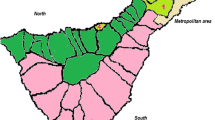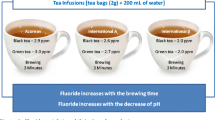Abstract
Fluoride is a beneficial trace element for human health as its deficiency and excess levels can cause detrimental health effects. In Sri Lanka, dry zone regions can have excessive levels of fluoride in drinking water and can cause dental and skeletal fluorosis. In addition to drinking water, traditional habits of tea consumption can cause an additional intake of fluoride in the population. A total number of 39 locally blended black tea samples were collected from a village where chronic kidney disease with undetermined origin (CKDu) is prevalent. In addition, unblended tea samples were obtained from tea-producing factories. The fluoride contents in infusions of 2% weight per volume (w/v) were measured using calibrated ion-selective fluoride electrodes. The mean fluoride content was 2.68±1.03 mg/L in loose tea, 1.87±0.57mg/L in packed tea samples, and 1.14±0.55 mg/L in unblended tea. Repeated brewing of the same tea leaves showed that over 50% of fluoride leached into the solution in the first infusion. An estimate of the daily total average fluoride intake via tea consumption per person is 2.68 mg per day. With groundwater in many dry zone regions in Sri Lanka showing high fluoride levels that exceed 0.5 mg/L, the additional daily intake can rapidly exceed recommended thresholds of 2 mg/day. This can add to adverse health impacts that might also relate to CKDu.




Similar content being viewed by others
References
Abeywickrama HM, Wimalasiri KMS, Koyama Y, Uchiyama M, Shimizu U, Chandrajith R, Nanayakkara N (2020) Assessment of nutritional status and dietary pattern of a rural adult population in dry zone, Sri Lanka. Int J Environ Res Public Health 17(1):150. https://doi.org/10.3390/ijerph17010150
Ali S, Fakhri Y, Golbini M, Thakur SK, Alinejad A, Parseh I et al (2019) Concentration of fluoride in groundwater of India: a systematic review, meta-analysis and risk assessment. Groundwater for Sustainable Development 9:100224
Armienta MA, Segovia N (2008) Arsenic and fluoride in the groundwater of Mexico. Environ Geochem Health 30(4):345–353. https://doi.org/10.1007/s10653-008-9167-8
Balasooriya S, Munasinghe H, Herath AT, Diyabalanage S, Ileperuma OA, Manthrithilake H, Daniel C, Amann K, Zwiener C, Barth JAC, Chandrajith R (2019) Possible links between groundwater geochemistry and chronic kidney disease of unknown etiology (CKDu): an investigation from the Ginnoruwa region in Sri Lanka. Exposure and Health 12:823–834. https://doi.org/10.1007/s12403-019-00340-w
Cao J, Luo SF, Liu JW, Li Y (2004) Safety evaluation on fluoride content in black tea. Food Chem 88(2):233–236. https://doi.org/10.1016/j.foodchem.2004.01.043
Chan L, Mehra A, Saikat S, Lynch P (2013) Human exposure assessment of fluoride from tea (Camellia sinensis L.): A UK based issue? Food Research International 51(2):564–570. https://doi.org/10.1016/j.foodres.2013.01.025
Chandrajith R, Abeypala U, Dissanayake CB, Tobschall HJ (2007) Fluoride in Ceylon tea and its implications to dental health. Environ Geochem Health 29(5):429–434. https://doi.org/10.1007/s10653-007-9087-z
Chandrajith R, Diyabalanage S, Dissanayake CB (2020) Geogenic fluoride and arsenic in groundwater of Sri Lanka and its implications to community health. Groundw Sustain Dev 10:100359. https://doi.org/10.1016/j.gsd.2020.100359
Chandrajith R, Padmasiri JP, Dissanayake CB, Prematilaka KM (2012) Spatial distribution of fluoride in groundwater of Sri Lanka. Journal of the National Science Foundation of Sri Lanka 40(4):303
Daesslé LW, Ruiz-Montoya L, Tobschall HJ, Chandrajith R, Camacho-Ibar VF, Mendoza-Espinosa LG, Quintanilla-Montoya AL, Lugo-Ibarra KC (2009) Fluoride, nitrate and water hardness in groundwater supplied to the rural communities of Ensenada County, Baja California, Mexico. Environ Geol 58(2):419–429. https://doi.org/10.1007/s00254-008-1512-9
Dissanayake CB, Chandrajith R (1999) Medical geochemistry of tropical environments. Earth Sci Rev 47(3):219–258. https://doi.org/10.1016/S0012-8252(99)00033-1
Edmunds WM, Smedley PL (2013) Fluoride in natural waters. In: Essentials of medical geology. Springer, pp 311–336
EFSA-NDA (2013) European Food Safety Authority Panel on Dietetic Products, Nutrition, and Allergies. European Food Safety Authority Journal (11):1–46
Emekli-Alturfan E, Yarat A, Akyuz S (2009) Fluoride levels in various black tea, herbal and fruit infusions consumed in Turkey. Food Chem Toxicol 47(7):1495–1498. https://doi.org/10.1016/j.fct.2009.03.036
Fernando WBNT, Nanayakkara N, Gunarathne L, Chandrajith R (2019) Serum and urine fluoride levels in populations of high environmental fluoride exposure with endemic CKDu: a case–control study from Sri Lanka. Environ Geochem Health 42:1497–1504. https://doi.org/10.1007/s10653-019-00444-x
Gaciri SJ, Davies TC (1993) The occurrence and geochemistry of fluoride in some natural waters of Kenya. J Hydrol 143(3):395–412. https://doi.org/10.1016/0022-1694(93)90201-J
Ghosh A, Mukherjee K, Ghosh SK, Saha B (2013) Sources and toxicity of fluoride in the environment. Res Chem Intermed 39(7):2881–2915. https://doi.org/10.1007/s11164-012-0841-1
Gomez ML, Blarasin MT, Martínez DE (2009) Arsenic and fluoride in a loess aquifer in the central area of Argentina. Environ Geol 57(1):143–155. https://doi.org/10.1007/s00254-008-1290-4
Graham HN (1992) Green tea composition, consumption, and polyphenol chemistry. Prev Med 21(3):334–350. https://doi.org/10.1016/0091-7435(92)90041-F
Guo H, Wen D, Liu Z, Jia Y, Guo Q (2014) A review of high arsenic groundwater in Mainland and Taiwan, China: distribution, characteristics and geochemical processes. Appl Geochem 41:196–217
Horie H, Nagata T, Mukai T, Goto T (1992) Determination of the chemical form of fluorine in tea infusions by 19F-NMR. Biosci Biotechnol Biochem 56(9):1474–1475
ISO (1980) Tea- Prepartion of liqure for use in sensory tests. In I. S. I. 3103 (Ed.), (pp. 4): International Organization for Standardization, Switzerland.
Jacks G, Bhattacharya P, Chaudhary V, Singh KP (2005) Controls on the genesis of some high-fluoride groundwaters in India. Appl Geochem 20(2):221–228. https://doi.org/10.1016/j.apgeochem.2004.07.002
Kimambo V, Bhattacharya P, Mtalo F, Mtamba J, Ahmad A (2019) Fluoride occurrence in groundwater systems at global scale and status of defluoridation—state of the art. Groundw Sustain Dev 9:100223. https://doi.org/10.1016/j.gsd.2019.100223
Kruse E, Ainchil J (2003) Fluoride variations in groundwater of an area in Buenos Aires Province, Argentina. Environ Geol 44(1):86–89. https://doi.org/10.1007/s00254-002-0702-0
Kut KMK, Sarswat A, Srivastava A, Pittman CU, Mohan D (2016) A review of fluoride in african groundwater and local remediation methods. Groundw Sustain Dev 2-3:190–212. https://doi.org/10.1016/j.gsd.2016.09.001
Linhares DPS, Garcia PV, Amaral L, Ferreira T, dos Santos Rodrigues A (2017) Safety evaluation of fluoride content in tea infusions consumed in the Azores—a volcanic region with water springs naturally enriched in fluoride. Biol Trace Elem Res 179(1):158–164. https://doi.org/10.1007/s12011-017-0947-9
Mehra A, Lynch P, Saikat S, Chan L (2013) Trace elements in tea (Camellia sinensis) and their bioavailability. Tea in Health and Disease Prevention 257274
Miri M, Bhatnagar A, Mahdavi Y, Basiri L, Nakhaei A, Khosravi R, Eslami H, Ghasemi SM, Balarak D, Alizadeh A, Mohammadi A, Derakhshan Z, Fallahzadeh RA, Taghavi M (2018) Probabilistic risk assessment of exposure to fluoride in most consumed brands of tea in the Middle East. Food Chem Toxicol 115:267–272
Mullane DMO, Baez RJ, Jones S, Lennon MA, Petersen PE, Rugg-Gunn AJ et al (2016) Fluoride and oral health. Community Dent Health 33(2):69–99
Ophaug RH (1990) Fluoride. Present knowledge in nutrition 6:274–278
Rafique T, Naseem S, Usmani TH, Bashir E, Khan FA, Bhanger MI (2009) Geochemical factors controlling the occurrence of high fluoride groundwater in the Nagar Parkar area, Sindh, Pakistan. J Hazard Mater 171(1):424–430. https://doi.org/10.1016/j.jhazmat.2009.06.018
Ranasinghe N, Kruger E, Chandrajith R, Tennant M (2019) The heterogeneous nature of water well fluoride levels in Sri Lanka: an opportunity to mitigate the dental fluorosis. Community Dent Oral Epidemiol 47(3):236–242. https://doi.org/10.1111/cdoe.12449
Rango T, Jeuland M, Manthrithilake H, McCornick P (2015) Nephrotoxic contaminants in drinking water and urine, and chronic kidney disease in rural Sri Lanka. Sci Total Environ 518-519:574–585. https://doi.org/10.1016/j.scitotenv.2015.02.097
Rasool A, Farooqi A, Xiao T, Ali W, Noor S, Abiola O, Ali S, Nasim W (2018) A review of global outlook on fluoride contamination in groundwater with prominence on the Pakistan current situation. Environ Geochem Health 40(4):1265–1281. https://doi.org/10.1007/s10653-017-0054-z
Reddy AGS, Reddy DV, Rao PN, Prasad KM (2010) Hydrogeochemical characterization of fluoride rich groundwater of Wailpalli watershed, Nalgonda District, Andhra Pradesh, India. Environ Monit Assess 171(1):561–577. https://doi.org/10.1007/s10661-009-1300-3
Szymczycha-Madeja A, Welna M, Pohl P (2019) Simplified method of multi-elemental analysis of dialyzable fraction of tea infusions by FAAS and ICP OES. Biological Trace Element Research:1–19
USEPA (1992) Guidelines for Exposure Assessment-EPA/600/Z-92/001; risk assessment forum. United State Environmental Protection Agency, Washington, DC.
Valenzuela-Vásquez L, Ramírez-Hernández J, Reyes-López J, Sol-Uribe A, Lázaro-Mancilla O (2006) The origin of fluoride in groundwater supply to Hermosillo City, Sonora, México. Environ Geol 51(1):17–27. https://doi.org/10.1007/s00254-006-0300-7
Wen D, Zhang F, Zhang E, Wang C, Han S, Zheng Y (2013) Arsenic, fluoride and iodine in groundwater of China. J Geochem Explor 135:1–21
WHO (1994) World Health Organisation—expert committee on oral health status and fluoride use (Fluorides and oral health, Vol. Technical Report Series No. 846). Geneva: WHO.
WHO (2002) Environmental health criteria 227: fluorides. World Health Organization, Geneva
Wickramarathna S, Balasooriya S, Diyabalanage S, Chandrajith R (2017) Tracing environmental aetiological factors of chronic kidney diseases in the dry zone of Sri Lanka—a hydrogeochemical and isotope approach. J Trace Elem Med Biol 44:298–306. https://doi.org/10.1016/j.jtemb.2017.08.013
Yadav KK, Kumar S, Pham QB, Gupta N, Rezania S, Kamyab H, Yadav S, Vymazal J, Kumar V, Tri DQ, Talaiekhozani A, Prasad S, Reece LM, Singh N, Maurya PK, Cho J (2019) Fluoride contamination, health problems and remediation methods in Asian groundwater: a comprehensive review. Ecotoxicol Environ Saf 182:109362. https://doi.org/10.1016/j.ecoenv.2019.06.045
Funding
This research was funded by a National Science Foundation (NSF) research grant RPHS/2016/CKDu/06 and German Federal Ministry of Education and Research (BMBF) (Grant Number 01DP17042).
Author information
Authors and Affiliations
Contributions
RC—conceptualization, data interpretation, project supervision, funding acquisition, writing, designed the final version of the manuscript; SB—data curation, sample collection, and laboratory analyses; SD—data analyses, visualization, draft preparation; SW—conceptualization, preliminary data interpretation, project supervision; MR—sample collection and data curation; JACB—project supervision, funding acquisition, writing, reviewing and editing.
Corresponding author
Ethics declarations
Competing Interests
The authors declare no competing interests.
Additional information
Publisher’s Note
Springer Nature remains neutral with regard to jurisdictional claims in published maps and institutional affiliations.
Rights and permissions
About this article
Cite this article
Chandrajith, R., Bhagya, S., Diyabalanage, S. et al. Exposure Assessment of Fluoride Intake Through Commercially Available Black Tea (Camellia sinensis L.) from Areas with High Incidences of Chronic Kidney Disease with Undetermined Origin (CKDu) in Sri Lanka. Biol Trace Elem Res 200, 526–534 (2022). https://doi.org/10.1007/s12011-021-02694-2
Received:
Accepted:
Published:
Issue Date:
DOI: https://doi.org/10.1007/s12011-021-02694-2




